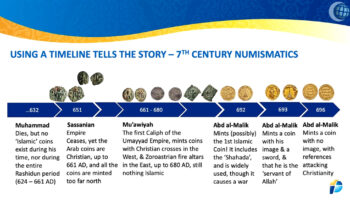Coins don’t lie.
The historical data from coins can’t be altered, obscured or rationalized.
Coins from the emerging Arab Empire tell a frightening story (it’s only frightening for those who believe in Islam).
The story they tell undermines the standard Islamic narrative.
“The earliest history of Islam is questionable at all levels,” remarks Al Fadi, on a CIRA International video. “The so-called Islamic coins debunk Islam itself.”

First off, there are no coins minted in Mecca or Medina during the 7th Century (when Arabs arose). According to Islam’s narrative, Mohammad and his followers rose out of Mecca and Medina to conquer the world with the powerful sword of Allah.
But NONE of the earliest coins minted by his followers emanated from either Mecca or Medina. (The coins have the city of minting on them.)
They were minted hundreds of miles to the North in Jordan and Lebanon: Illya, Yubna, Amman, Jerash, Baysan, Abila, Tebariya, Dimashq, Ba’albak, Hinis, Tartus.
(This survey excludes coins from Yemen and Oman, from the Byzantine Empire based in Modern Turkey and the Zoroastrian coins from around Modern Iran and Kuwait.)
Since rulers minted coins from their homebase, this tells us that none of the early Caliphs were based where they were supposed to be in the Hejaz (of Medina and Mecca).

In fact, according to ancient maps, Mecca didn’t even exist.
This is troubling for Muslims because if their history is questionable, logically everything they believe is likewise questionable.
But it gets worse for the standpoint of their historical narrative.
The earliest coins of Arab rulers show they were Christian, according to Dr. Jay Smith.
Coins from the Sassanians (651-660) have crosses on them, showing they were Christian (as opposed to Zororastrian coins which had an emblem of fire altars on them). According to the SIN, the Sassanians were Muslim.
The first Umayyad Caliph, Mu’awiyah (661-680) put three crosses on his western coins, a nod to the Trinity. According to the SIN, Mu’awaiyah was Muslim.

“If Mohammad died in 632, we’re 50 years later, the coins are either Christian or Zoroarastrian,” Dr. Smith says. “There is nothing at all that is close to Islam.”
The first hint of Muslim doctrine comes in 692 when Abd al-Malik announces his leadership to the world with a coin that says: “There is no god but Allah and MHMD is his prophet.”
This is the proto-shahada proclamation that Muslim use to make converts (their version of a Christian’s “sinner’s prayer.”)
Dr. Smith puts forth an intriguing theory that Abd al-Malik may NOT have even been a Muslim, but rather a Christian anti-Trinitarian.
“It’s attacking Byzantine Christianity,” Dr. Smith contends.
Dr. Smith believes the lack of convincing evidence of Islam from the 7th Century undermines their case. “Coins are brilliant; they don’t disintegrate, they don’t deteriorate. They’re usually as pristine today as the day they’re minted. All the early coins have a Christian identity. This is an internecine Christian attack. These coins are telling us there is a debate that is happening between the Trinitarians and the anti-Trinitarians.”
To learn more about a personal relationship with Jesus, click here
Related articles:
- He left Hezbollah and Islam.
- He’s converted 100M Muslims to Christianity, so Al-Qaeda wants him dead.
- Does Islam plan to take over Europe with violence?
- Is Islam inherently violent? Look at the history.
- Why are Europeans converting to Islam?
- Sharia law in London is practiced locally and internally.
About this writer: Michael Ashcraft pastors a church in the San Fernando Valley of Los Angeles.





[…] From God Reports […]
[…] Century coins expose fabrications of Islam’s […]
[…] Century coins undermine Islamic historical […]
Comments are closed.